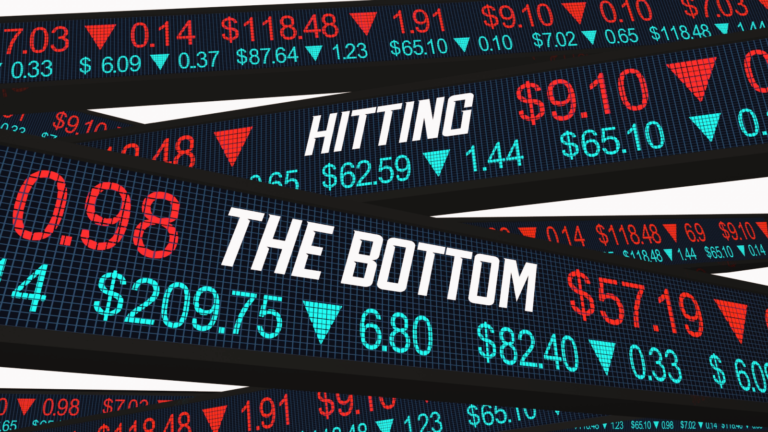History may not always repeat on Wall Street, but it does rhyme. And investors who don’t learn the lessons from Wall Street’s colorful past are doomed to never make money in the markets.
This is especially true during bear markets.
About once every decade, the stock market crashes. The crash’s cause and intricate details are always different. But the characteristics – and investor psychology during these crashes – are often the same every time.
While most act like every stock market crash is the end of the world, the investors who study history tend to remain calm. They are the ones that can identify the generational investment opportunities presented in bear markets.
Simply consider these two facts:
- Bear markets always turn into bull markets.
- Trying to time their bottom is unnecessarily risky (but everyone tries anyway).
Considering these facts – and given where we are in the current market cycle (down more than 25% from recent highs and about 12 months into this bear market) – the historical data is crystal clear on its advice for investors in October 2022. Just ignore the noise, and buy the dip.
2023 is shaping up to be a record-breaking year for stocks.
Here’s why.
- 1,000% Divergence Window Now Closing! Watch the emergency briefing.
Stocks Always Soar After Crashing 25%
The S&P 500 is down 25% in 2022. That’s both scary and so very exciting.
Of course, it’s scary because stocks crashing 25% is a sign that Wall Street thinks the global economy is in trouble. And it is. Central banks around the world are embarking on unprecedented fast and aggressive rate-hike cycles while the global economy is dramatically slowing. That’s a recipe for a recession.
Scary stuff…
But the market being down 25% is also so exciting. Indeed, since 1950, whenever stocks have been in a similar situation, they pretty much always soared over the next year, gaining about 20% on average. And that’s even if a recession or even a global depression followed.
They also ALWAYS soared over the next three years (average returns: 37%)… over the next five years (average returns: 83%)… and over the next 10 years (average returns: 214%).
In other words, history says that we’re currently amid one of the greatest buying opportunities in stock market history.
If so, then why aren’t you buying the dip?
Timing the Bottom Is a Fool’s Errand
When I ask investors why they aren’t buying the dip today, the most common response is this. Well, I don’t think stocks have bottomed yet.
I agree. Stocks likely haven’t bottomed yet. But who cares?
If history says stocks are going to soar over the next one, three, five, and 10 years, then does it really matter if they drop a little more over the next few weeks?
It shouldn’t, especially when you consider that waiting for the market bottom has an enormous opportunity cost.
Here’s the thing about bear-market bottoms. They happen in one day, and then they’re gone forever.
If you catch it, congratulations. But most of us won’t catch the exact bottom. Instead, we will sit around waiting for a bottom, afraid to buy the dip. Then, by the time we recognize a bottom has arrived, stocks will likely have already soared.
And missing those gains can hurt massively.
Simply consider this: The stock market has risen 17,715% since 1930. That’s an enormous number. But a big chunk of those gains came on massive single-day rallies. Had you missed the 10 best trading days every decade, that 17,715% return would shrink to just 28%.
In other words, the stock market’s gains are highly concentrated. And they are concentrated around big rallies after market bottoms. So, if you miss those rallies – which is the risk you run by sitting around and waiting for a bottom – you’re missing out on some huge gains.
Don’t miss out on the chance to make thousands of percent by trying to time a market bottom you’ll likely miss.
Instead, embrace this bear market. And turn short-term pain into long-term gain by following the guide of history and buying the dip.
- Divergence is closing, and Luke Lango is delivering his #1 pick in an emergency briefing. Tune in.
The Final Word on the Market Bottom
I’ll be the first to say that the stock market likely has not bottomed yet.
I’ll also be the first to say that you should be buying stocks today.
The simple reality is that all bear markets turn into bull markets. And over the past 70 years, there has never been a situation where stocks dropped as much as they have in 2022 and weren’t 20%-plus higher five years later. In fact, stocks are usually about 80% higher five years down the road.
Therefore, anybody with a multi-year time horizon should be buying stocks today.
But if you want to maximize your returns in the coming market rebound, you need to buy one type of stock in particular.
On the date of publication, Luke Lango did not have (either directly or indirectly) any positions in the securities mentioned in this article.


